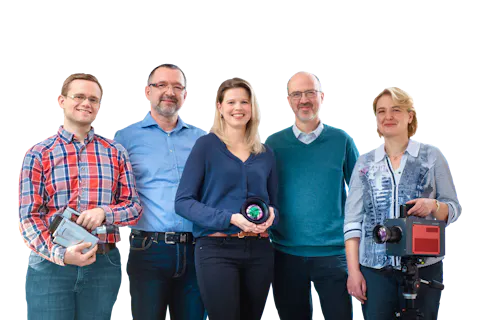Frequently Asked Questions About Thermography
Some things you just want to know more precisely. No matter whether it is a matter of a concrete practical application or a more general background information is required. In the FAQ, we have answered a few of the questions that customers often address to us. We hope the answers will help you solve your task. What you want to know, is not mentioned here? Then you can contact us by phone and e-mail at any time. Or simply use our contact form.

Both terms refer to a device that is capable of registering the intensity spread of infrared radiation within a setting, visualising it as an image. While an infrared camera (also known as “imager” or “(passive) nightviewer”) rather serves to improve the perceptibility of people or objects in the dark or in hampered visibility, the task of the thermographic camera goes even one step further, i.e., its calibration permits to conclude the surface temperature of objects from the intensity of the detected infrared radiation.
In the vast majority of materials it is practically zero, i.e., measuring directly takes place on the material surface. There are only very few (partially) transmittant materials, such as oxides or silicates, where the measured value composes of layers that are at different depths within the object.
Not as a rule, since glass is transmittant by visible light in the same way as is near infrared, however, it is not beyond a wavelength of approx. 4 µm. This spectral range requires special infrared-transmittant window materials.
This, first of all, depends on the capability of the thermographic camera applied. State-of-the-art thermographic cameras permit non-contact temperature measuring as low as -40 °C. Below this range, however, the infrared intensity irradiated by objects, and thus their signal-to-noise ratio, decreases so heavily that even considerable increases in device sensitivity would merely yield minute reductions of the lower measuring limit.
This is a question of wavelength. Infrared remote controls and infrared data-transfer distances make use of wavelengths in the near infrared range (e.g. 0.85 µm or 1.55 µm), while thermographic cameras work within the so-called “thermal infrared”, i.e., beside the more rarely applied range of 3 ... 5 µm, usually at 8 ... 14 µm – exactly the range in which also bodies show their maximum irradiation at room temperature.
Only under certain conditions; for the most frequent gases (such as the majority of constituents of the earth atmosphere) are largely translucent in the infrared range. Several gases, such as carbon and nitrogen oxides, also emit infrared radiation by themselves, although only within very narrow spectral ranges, so-called “bands“. Accordingly fitting spectral filters in the thermographic camera permit to adjust to this fact; however, it must be borne in mind that this requires a minimum temperature of typically a few hundred degrees Celsius as well as a minimal thickness of the gaseous layer to be measured.
Yes. The high-end infrared cameras of the ImageIR® series are developed and manufactured at InfraTec's headquarters in Dresden. In production, approximately 20 employees configure the modular cameras according to requirements and the specific measurement and testing situation. The selection of the appropriate precision infrared lenses is also carried out at InfraTec. The cameras are calibrated on site using a fully automatic calibration machine.
The high-end infrared cameras of the ImageIR® series are developed and built at the company's headquarters in Dresden. A team of experienced scientists, engineers, and technicians are constantly working to improve the products and open up new areas of application for InfraTec cameras.
The ImageIR® infrared cameras are unique: each of the modular devices is manufactured in a modern production facility according to customer requirements and calibrated on a fully automated calibration stand.
Within Europe, there are no customs or trade restrictions on InfraTec infrared cameras or on the products used by suppliers in their production concerning InfraTecs infrared cameras. Our strategic purchasing and professional supplier management ensure the availability of our infrared cameras at competitive prices.
None of the cameras sold by InfraTec are subject to the International Traffic in Arms Regulations, the US government's regulations for controlling the export and import of defense goods and services. The classification as ITAR-free allows worldwide export, for example to the USA or China.
InfraTec products are used worldwide. The delivery of infrared cameras is organized from the headquarters in Dresden, where experienced employees take care of all formalities such as the preparation of waybills, packing lists, customs declarations, etc., and ensure compliance with import and export regulations. InfraTec relies on established logistics service providers for the transport and delivery of infrared cameras.
Infrared cameras are high-quality, technically complex products. InfraTec supports its customers far beyond the purchase of a thermography system. The in-house service department staff assist users with questions or technical challenges, for example, via remote maintenance. They also recalibrate infrared cameras as needed.
InfraTec offers a comprehensive range of accessories. In the event of a defect, replacement parts can be provided at short notice. In addition, the accessories offer the opportunity to flexibly adapt testing and measurement systems to new and changing tasks.

Do You Have Questions? We Are Here For You!
Many requirements call for customized solutions. Our specialists provide personal support – whether you have technical questions, need assistance in selecting suitable system solutions, or want to ensure the optimal use of your infrared camera. Give us a call or send us an email. Together, we will find the right solution.